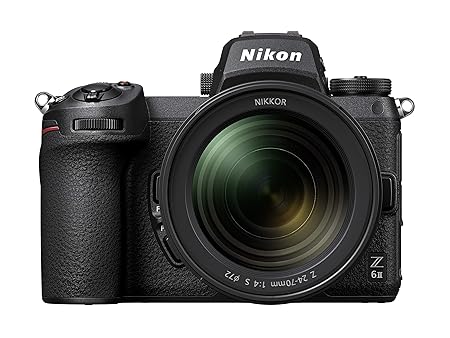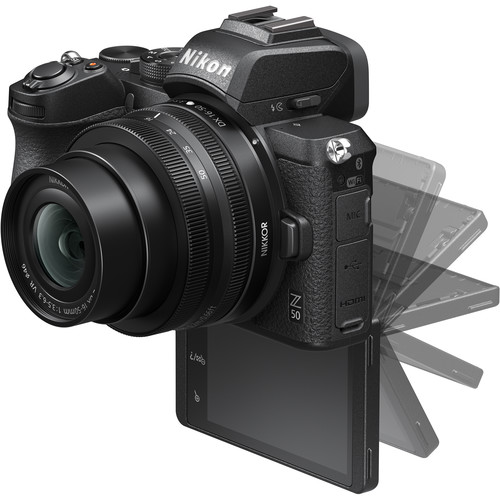Nikon Z50 Revealed: Detailed Look at Nikon’s Compact Mirrorless
The Nikon Z50 is a versatile mirrorless camera designed to offer a blend of high-performance features and portability. As a member of Nikon’s renowned Z series, the Z50 aims to provide a powerful imaging solution in a compact and user-friendly package. This review delves into the camera’s design, performance, connectivity, and more, giving you an in-depth understanding of what makes the Nikon Z50 a standout choice for photographers and videographers.
Introduction to the Nikon Z50
The Nikon Z50 is a mirrorless camera that combines advanced technology with a compact design. Launched as a part of Nikon’s Z series, the Z50 is aimed at providing users with a lightweight, versatile camera that does not compromise on performance. Its features make it suitable for various types of photography, from everyday snapshots to more complex creative projects.
Nikon Z50 Specifications
- Sensor Resolution: 20.9 MP
- Sensor Type: BSI CMOS
- Sensor Size: 23.5 × 15.6mm
- Sensor Pixel Size: 4.22 µ
- Optical Low Pass Filter: No
- In-Body Image Stabilization: No
- Image Size: 5568 × 3712
- Image Processor: EXPEED 6
- Viewfinder Magnification: 1.02× (0.67× FF equivalent)
- Built-in Flash: Yes
- Storage Media: 1× SD, UHS-I Compatible
- Continuous Shooting Speed: 11 FPS
- Electronic Shutter: Yes
- Shutter Speed Range: 1/4000 to 30 seconds
- Native ISO Sensitivity: 100-51,200
- Boosted ISO Sensitivity: 102,400-204,800
- Focus Points: 209 focus points
- On Sensor Phase Detection: Yes
- Video Maximum Resolution: 4K up to 30 FPS (No Crop), 1080p up to 120 FPS
- LCD Size, Type and Resolution: 3.2″ Tilt-down 1,040,000-dot Touchscreen
Image Quality
| Effective Still Resolution | 20.9 MP |
|---|---|
| Aspect Ratio | Unknown |
| File Format | RAW, JPEG |

About this item
- NIKON USA AUTHORIZED – Includes Full NIKON USA WARRANTY
- Superior rendering performance and rich power of expression have been concentrated into a compact and lightweight body with the Nikon DX-format Z 50 Mirrorless Camera. | Equipped with the EXPEED 6 image-processing engine for imaging characteristics similar to those of the Z 7 and Z 6 | Z Mount Advantage: Supports both the NIKKOR Z DX and NIKKOR Z FX formats, so all NIKKOR Z lenses can be used with the Z 50
- 4K UHD Movie Recording in DX-format based full-frame | Also supports recording of 4K UHD movies without any crop | Equipped with a variety of cinematic movie-recording functions, including a slow-motion movie function and a time-lapse movie function that generates 4K UHD and Full HD time-lapse movies in-camera.
- 209 focus points offer wide AF coverage in the frame – approx. 87% horizontal and 85% vertical | Eye-detection AF for amazingly sharp and impressive portraits | Equipped with a manual pop-up flash | 3.2-inch, approx. 1040k-dot 180░ tilting TFT touch-sensitive LCD monitor – Flip down the LCD screen to activate Self Portrait Mode perfect for taking selfies and for vlogging. | Built-in Wi-Fi and Bluetooth connectivity make sharing a snap with Nikon’s SnapBridge app available for Apple or Android.
When evaluating the Nikon Z50 in comparison to other Nikon cameras, it’s essential to understand its unique position within Nikon’s lineup. Here’s a breakdown of how the Z50 stacks up against other popular Nikon models, such as the Nikon D7500 and the Nikon Z6.
Nikon Z50 vs. Nikon D7500: Key Differences and Features
The Nikon D7500 is a well-regarded DSLR that offers robust performance and features. However, the Z50, being a mirrorless camera, presents several advantages and differences:
- Sensor and Image Quality:
- Nikon Z50: Equipped with a 20.9MP APS-C sensor, the Z50 delivers high-resolution images with impressive detail and clarity.
- Nikon D7500: Features a 20.9MP APS-C sensor as well, but being a DSLR, it may not offer the same level of image preview accuracy through the viewfinder.
- Body and Portability:
- Nikon Z50: The Z50’s compact and lightweight design makes it highly portable, ideal for travel and everyday shooting.
- Nikon D7500: While robust and durable, the D7500 is larger and heavier, which can be less convenient for on-the-go photography.
- Autofocus System:
- Nikon Z50: Includes a hybrid autofocus system with eye-detection technology for precise focus on portraits and dynamic scenes.
- Nikon D7500: Utilizes a 51-point phase-detection system, which is effective but may not match the Z50’s advanced eye-detection capabilities.
- Video Capabilities:
- Nikon Z50: Supports 4K UHD video recording and offers Full HD slow-motion options, catering to high-quality video needs.
- Nikon D7500: Also supports 4K UHD video but lacks the slow-motion recording features of the Z50.
Nikon Z50 vs D7500: A Side-by-Side Camera Comparison
The Nikon Z6 is a full-frame mirrorless camera that offers high-end features. Here’s how the Z50 compares to the Z6:
- Sensor Size:
- Nikon Z50: Uses a 20.9MP APS-C sensor, which is smaller than the Z6’s full-frame sensor.
- Nikon Z6: Boasts a 24.5MP full-frame sensor, offering better low-light performance and depth of field control.
- Price Point:
- Nikon Z50: Positioned as a more affordable option, making it accessible for enthusiasts and those new to mirrorless photography.
- Nikon Z6: Positioned as a higher-end model with a correspondingly higher price tag, suitable for professionals seeking advanced capabilities.
- Viewfinder:
- Nikon Z50: Features a 2.36-million-dot OLED electronic viewfinder, providing a clear and detailed view.
- Nikon Z6: Equipped with a higher-resolution 3.69-million-dot OLED viewfinder, offering an even more detailed viewing experience.
- Lens Compatibility:
- Nikon Z50: Utilizes the Z-mount system with access to a growing range of lenses and can use F-mount lenses via the FTZ adapter.
- Nikon Z6: Also uses the Z-mount but supports a broader range of high-end lenses and offers native compatibility with both Z-mount and F-mount lenses through the FTZ adapter.
Conclusion
In summary, the Nikon Z50 stands out for its compact design, advanced autofocus, and user-friendly features, making it an excellent choice for those who prioritize portability and ease of use. While it may not have the full-frame sensor of the Z6 or the rugged build of the D7500, it offers a compelling blend of performance and convenience for a variety of photographic needs. Whether you’re looking for an entry-level mirrorless camera or a versatile, travel-friendly option, the Nikon Z50 delivers a strong combination of features at a competitive price.
The Nikon Z50 stands out as a powerful yet compact mirrorless camera that offers a rich set of features and exceptional performance. Its combination of a high-resolution sensor, advanced autofocus system, and versatile connectivity options make it a strong choice for photographers and videographers alike. Whether you’re an amateur looking to upgrade your gear or an experienced photographer seeking a portable backup camera, the Nikon Z50 delivers quality and convenience in a sleek package.
By incorporating a range of features designed to enhance both image and video quality, the Nikon Z50 meets the needs of a diverse user base. Its compact design does not compromise on performance, making it a valuable tool for capturing high-quality content on the go. With its competitive pricing and comprehensive feature set, the Nikon Z50 is a notable addition to the world of mirrorless cameras, offering both functionality and ease of use in a compact form factor.


